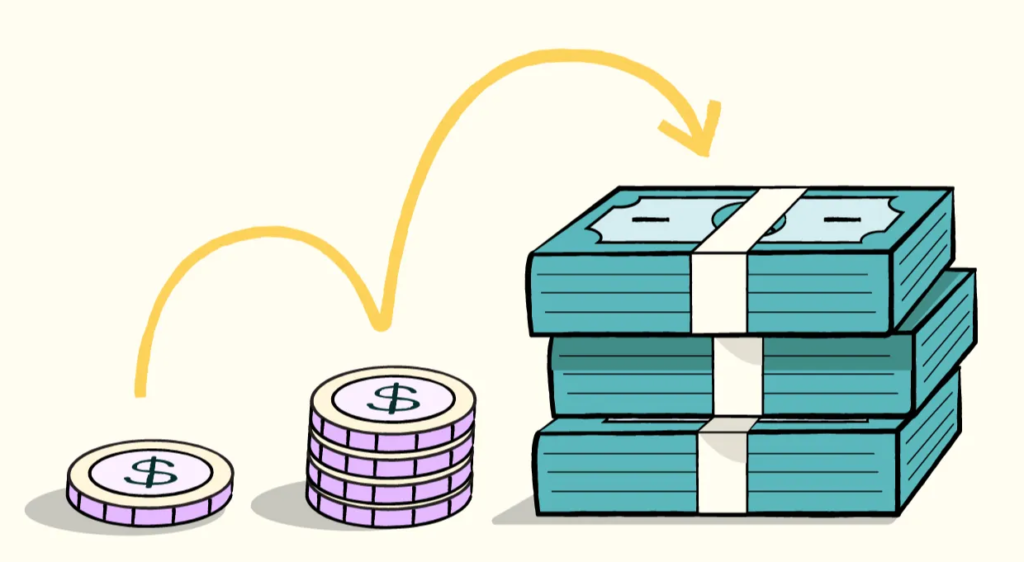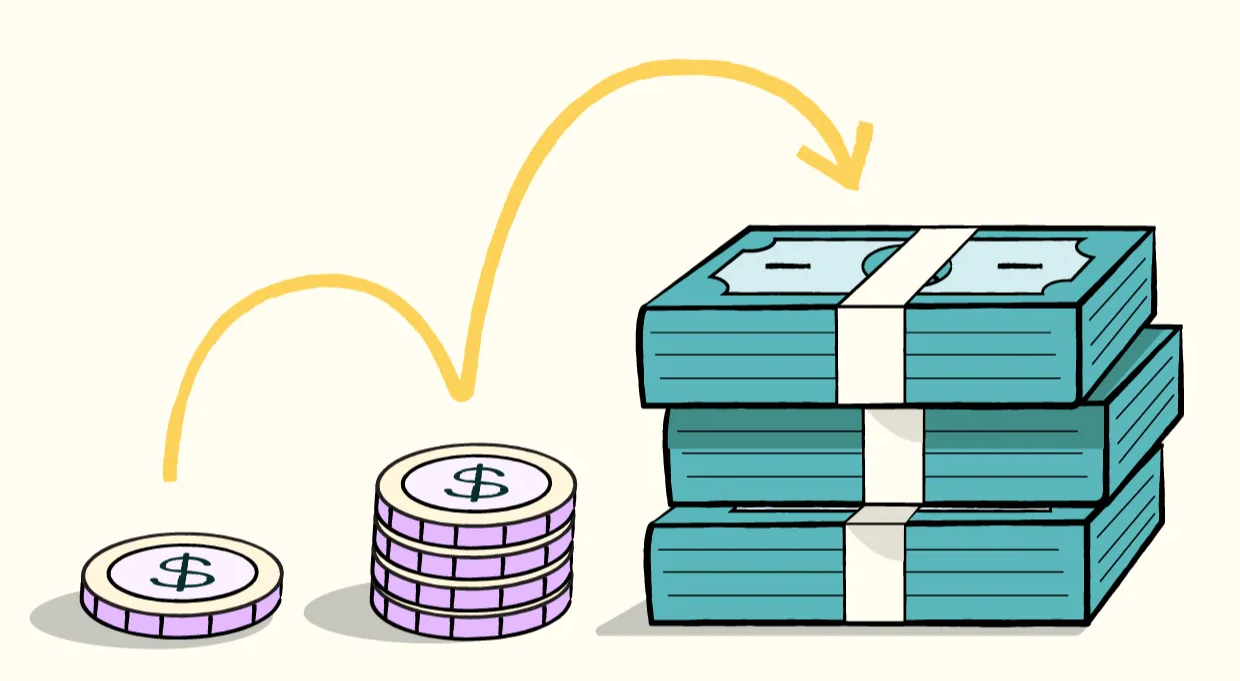Investing wisely is key to building wealth over time. Understanding compound interest can help you grow your money faster. This article will teach you how to use compound interest to increase your investments.
If you’re new to investing or want to improve your portfolio, this guide is for you. It offers insights and strategies to make the most of compound interest. This will help you reach your financial goals.

Key Takeaways
- Compound interest is the interest earned on interest, which can lead to exponential growth over time.
- Investing consistently and starting early are critical to maximizing the benefits of compound interest.
- Effective investment strategies, such as long-term investing and dividend reinvestment, can amplify the power of compound interest.
- Properly managing risk and diversifying your portfolio are essential to mitigating the potential downside of compound interest.
- Tax-advantaged investment accounts can further boost the impact of compound interest on your wealth-building efforts.
Understanding Compound Interest
Compound interest is a key financial idea that can grow your wealth over time. It’s the interest on top of interest, leading to big investment gains. To use compound interest well, knowing how it works and how it’s different from simple interest is key.
What Is Compound Interest?
Compound interest is when you earn interest on the money you start with and the interest that money has already made. This is unlike simple interest, which only looks at the starting money. With compound interest, the interest from each period adds to the total, and the next period’s interest is based on this new total.
The formula for compound interest is: A = P(1 + r/n)^(nt), where A is the final amount, P is the principal, r is the annual interest rate, n is the number of times interest is compounded per year, and t is the time in years.
The Math Behind Compound Interest
Compound interest’s power comes from its exponential growth. As time goes on, the money grows faster and faster. Small changes in interest rates or time can greatly affect the final amount.
For instance, investing $10,000 at a 6% annual rate, compounded monthly, for 20 years makes it about $32,071. But at an 8% rate, it’s around $46,610. That’s a $14,000 difference from a 2% higher interest rate.
| Investment Amount | Interest Rate | Time Period | Final Amount |
|---|---|---|---|
| $10,000 | 6% (compounded monthly) | 20 years | $32,071 |
| $10,000 | 8% (compounded monthly) | 20 years | $46,610 |
This example shows how compound interest can greatly increase your investment over time. Knowing the math behind it helps you make better choices and grow your wealth.
The Power of Compound Interest: How to Grow Your Wealth Over Time
Compound interest is a powerful way to grow your money over time. It makes even small investments grow into a lot of wealth. This happens because your earnings earn more earnings, creating a snowball effect that speeds up your wealth growth.
Picture putting $5,000 away each year, earning an average 7% return. After 30 years, that money would grow to a huge $418,305. The secret is to start early and let wealth growth and investment compounding work for you.
Long-term investing is a great way to use compound interest. By adding to your investments regularly and letting them grow over years, you can build a big savings for the future. The sooner you start, the more time your money has to grow, leading to bigger returns.
| Investment Amount | Annual Return | Time Horizon | Total Value |
|---|---|---|---|
| $5,000 | 7% | 30 years | $418,305 |
| $10,000 | 8% | 40 years | $1,672,964 |
| $15,000 | 6% | 20 years | $452,132 |
These examples show how compound interest can greatly increase your wealth over time. By starting early, investing regularly, and letting your money compound, you can create a strong financial base for the future.
“Compound interest is the eighth wonder of the world. He who understands it, earns it … he who doesn’t… pays it.” – Albert Einstein
To make the most of compound interest, you need a long-term view and a disciplined investment plan. This way, you can fully tap into your money’s potential and reach your financial goals.

Investing Strategies for Compound Growth
Using compound interest well needs smart investment plans. Two main strategies can boost compounding: buy-and-hold and dollar-cost averaging.
Long-Term Investment Strategies
The buy-and-hold strategy means buying top-quality assets and keeping them for a long time. This lets compound interest work its magic. It reduces the effect of short-term market ups and downs, focusing on long-term growth.
Dollar-cost averaging is about putting the same amount of money in at regular times, no matter the market price. This method helps even out your investment risks. It means buying more shares when prices are low and fewer when they’re high. This helps with compounding.
Dividend Investing for Compounding
Dividend investing is great for using compound interest. By choosing companies that pay steady dividends, you can use those dividends to buy more shares. This way, your money grows over time. It’s especially good for value investing and growth investing strategies.
For the best compound interest results, mix different investment strategies in your portfolio. Include dividend investing, value investing, and growth investing. This way, you get a balanced plan that uses compound interest to grow your money over the long term.

“Compound interest is the eighth wonder of the world. He who understands it, earns it… he who doesn’t, pays it.” – Albert Einstein
Risk Management and Asset Allocation
Mastering compound interest means being smart about risk and how you spread your investments. Growing your wealth over time requires diversifying your investments and understanding risks. This way, you can make the most of compound interest.
Portfolio diversification is key to managing risk. By investing in different areas like stocks, bonds, real estate, and more, you reduce the risk of losing money in one area. This balanced strategy helps you handle market ups and downs better.
Asset allocation is also vital. It’s about finding the right mix of investments based on your risk level, how long you can wait for returns, and your financial goals. A good asset allocation strategy helps you balance risk and return, which is good for long-term growth.
Regularly checking your investments is important too. By keeping an eye on your investments and adjusting when needed, you can keep your portfolio on track with your financial goals.
| Asset Class | Risk Assessment | Allocation Percentage |
|---|---|---|
| Stocks | Moderate to High | 60% |
| Bonds | Low to Moderate | 30% |
| Real Estate | Moderate | 10% |
By taking a full approach to managing risk and allocating assets, you can fully use compound interest. This helps you build a strong, varied portfolio that can handle market changes over time.
“Diversification is the only free lunch in investing.” – Harry Markowitz, Nobel Laureate in Economics
Tax Implications of Compounding
Building wealth through compound interest means thinking about taxes. The way you use tax strategies can greatly affect how much you gain. By using tax-advantaged accounts, you can grow your money better and keep more of it.
Tax-Advantaged Investment Accounts
Using tax-advantaged accounts like 401(k)s and IRAs is a smart move. These accounts offer big tax benefits that help your wealth grow faster.
- 401(k) plans let you put in pre-tax dollars, lowering your taxes now. This lets your money grow without taxes until you retire.
- Traditional IRAs also grow without taxes until you take money out.
- Roth IRAs grow tax-free and let you take money out without taxes in retirement. This is a great way to save on taxes over time.
These accounts help you make the most of compound interest. They let you keep more of your earnings, not give it to the government.
| Account Type | Tax Advantages | Contribution Limits (2023) |
|---|---|---|
| 401(k) | Contributions are made with pre-tax dollars, and growth is tax-deferred until withdrawal. | $22,500 ($30,000 for those aged 50 and above) |
| Traditional IRA | Contributions may be tax-deductible, and growth is tax-deferred until withdrawal. | $6,500 ($7,500 for those aged 50 and above) |
| Roth IRA | Contributions are made with after-tax dollars, and qualified withdrawals are tax-free. | $6,500 ($7,500 for those aged 50 and above) |
Knowing about tax-advantaged accounts helps you plan your investments better. This way, you can make the most of compound interest and save on taxes.
The Psychological Aspects of Compounding
Using compound interest needs a long-term mindset and steady discipline. This part looks at how your mind affects your ability to keep going and enjoy the benefits of compounding. Key factors include patience, delayed gratification, and controlling your feelings.
Patience and Discipline
Getting rich with compound interest takes time. It’s all about being patient and disciplined in your investments. These traits are key to handling market ups and downs and avoiding quick, bad decisions.
Delayed gratification is crucial for making the most of compound interest. It means waiting for big rewards later instead of taking quick gains. This mindset helps you avoid cashing out too soon and let your money grow over time.
Managing your feelings is also key with compound interest. Market ups and downs can make you feel scared or anxious, leading to bad choices. Staying calm and rational helps you stick to your plan and reach your goals.
The mental side of compounding is as important as the math. By being patient, disciplined, and in control of your feelings, you can stick with it and enjoy the benefits of compound interest.
Compound Interest in Real Estate Investing
Real estate investing is a great way to use compound interest. It’s different from other investments because it can grow your money in two ways: through property value increases and rental income. Knowing how compound interest works in real estate can help you grow your wealth over time.
Real estate has a big advantage: property value can go up. If your property’s value goes up by 5% each year, it could be worth over $400,000 in 10 years. This is because the money you make from the increase adds to your investment, making it grow even more.
Rental income is another way to build wealth. By renting out your property, you get regular money that you can use to grow your investments. This money can make your investments grow faster, creating more wealth over time.
| Key Factors in Real Estate Compound Growth | Impact on Wealth Building |
|---|---|
| Property Appreciation | Increases the value of your real estate assets, leading to significant long-term gains |
| Rental Income | Provides a steady stream of cash flow that can be reinvested to further grow your portfolio |
| Leveraging Mortgages | Allows you to control a larger real estate portfolio with a smaller initial investment, amplifying the compounding effect |
Understanding compound interest and applying it to real estate can help you build wealth. You can grow your money through property value increases, rental income, or using mortgages. Real estate is a great way to make your money work for you over time.
To make the most of compound interest in real estate, think long-term and make smart choices. Reinvesting your earnings can help your investments grow even more. This way, you can use compound interest to turn your real estate into a powerful tool for building wealth.
Automating Your Investments for Compounding
Automating your investments can boost the power of compound interest. By setting up regular transfers and passive income, your money can grow over time with little effort from you.
Investment automation is key to building wealth over the long term. It lets you manage your investments with a “set it and forget it” approach. This means your investments can keep growing without needing constant attention. It’s great for recurring contributions, where you can set up automatic transfers from your bank or paycheck.
Automating your contributions is just the start. You can also look into passive income streams that grow over time. Options include dividend-paying stocks, real estate, or peer-to-peer lending. These passive income sources can speed up the growth of your investments through compounding.
- Set up automatic transfers from your bank account or paycheck to your investment accounts, ensuring consistent recurring contributions.
- Explore passive income opportunities, like dividend stocks or real estate, that grow over time.
- Use tools and apps for investment automation to make managing your investments easier with less effort.
| Strategy | Benefit | Example |
|---|---|---|
| Investment automation | Hands-off approach to compounding | Automatically transferring $500 per month from your checking account to an index fund |
| Recurring contributions | Consistent investment growth | Setting up a monthly transfer of $200 from your paycheck to a Roth IRA |
| Passive income | Compounding through alternative revenue streams | Investing in a real estate crowdfunding platform that generates quarterly dividends |
Automating your investments and diversifying your income can help you use compound interest to grow your wealth with little effort. The key is to start early, invest regularly, and let your money work for you.
Historical Examples of Compound Interest
Compound interest has shown its power through many real-world examples. Successful investors, companies, and investment vehicles have grown their wealth over time. Let’s look at some inspiring stories that show the long-term growth from compounding.
The Snowball Effect: Warren Buffett’s Wealth Journey
Warren Buffett is a prime example of compound interest in action. He started with a small investment and grew it into a huge company, Berkshire Hathaway. Today, his net worth is over $100 billion. This shows how long-term growth and smart investment strategies can change fortunes.
Rockefeller’s Rise to Riches: The Power of Compounding
John D. Rockefeller, the founder of Standard Oil, is another great example. He used compound interest to build a massive fortune, over $400 billion today. Rockefeller’s success came from reinvesting his earnings and using compounding over many years.
| Investor | Initial Investment | Current Value | Growth Factor |
|---|---|---|---|
| Warren Buffett | $10,000 | $100+ billion | 10,000x |
| John D. Rockefeller | $1,000 | $400+ billion | 400,000x |
These investment case studies show how compound interest can change fortunes over time. By using compounding, these investors turned small investments into huge wealth.
“Compound interest is the eighth wonder of the world. He who understands it, earns it… he who doesn’t, pays it.”
– Albert Einstein, renowned physicist
The stories of Buffett, Rockefeller, and others remind us of the power of long-term growth with compound interest. As you start your investment journey, remember these examples. Aim to use the power of compounding to your advantage.
Tips for Maximizing Compound Interest
To really make the most of compound interest and grow your wealth over time, you need a solid investment plan. Here are some tips to boost your compound interest and reach your financial goals:
Start Early and Invest Consistently
Starting to invest early is crucial for compound interest success. The earlier you put money into your investments, the more time it has to grow. Even small, regular investments early on can grow into a big sum later.
It’s also important to keep investing regularly. Make a habit of adding money to your investments at the same time each month or quarter. This way, your money works hard for you without you having to think about it. Setting up automatic investments can keep you on track.
- Begin investing as early as possible to maximize the effects of compound interest
- Invest consistently, even if the amounts are small, to build wealth over time
- Automate your investments to maintain a disciplined, long-term approach
“Compound interest is the eighth wonder of the world. He who understands it, earns it… he who doesn’t, pays it.” – Albert Einstein
By starting early and sticking with it, you’re on your way to using compound interest tips to grow your long-term wealth. Remember, patience and discipline are essential for investment best practices that lead to success.
Conclusion
This article has shown how compound interest can change your financial future. Now, you know how to use this powerful tool to grow your money faster. This knowledge lets you speed up your progress towards your financial goals.
Whether you want to build a strong investment portfolio, plan for retirement, or grow your savings, this article has given you valuable advice. By using investment strategies, planning your finances, and sticking to your plan, you can increase your wealth creation over time.
The secret to using compound interest well is to start early, invest regularly, and be patient. If you follow these steps, you’ll be moving towards your financial dreams. You’ll also be securing a bright future for yourself and your family.
FAQ
What is compound interest and how does it work?
Compound interest is when you earn interest on both your initial investment and the interest it earns over time. This process can greatly increase your wealth if done right.
How can I maximize the power of compound interest in my investments?
Start investing early and put money in regularly. Use accounts like 401(k)s and IRAs that offer tax benefits. Choosing long-term strategies like buy-and-hold can also boost your returns.
What are the key investment strategies for harnessing compound interest?
Good strategies include long-term investing, focusing on dividends, and value investing. These methods help you benefit from compound interest over the years.
How does asset allocation and risk management impact compound interest?
Asset allocation and risk management are key. Diversifying your investments and managing risks can help your money grow over time. This approach also protects your investments.
What are the tax implications of compound interest, and how can I minimize their impact?
Taxes can affect your investment growth. Using accounts like 401(k)s and IRAs can reduce taxes and increase your growth potential.
How can I apply the principles of compound interest to real estate investing?
Real estate is great for growing wealth through compound interest. Factors like property value increases and rental income can help your wealth grow over time.
What psychological factors influence my ability to harness compound interest?
Success with compound interest requires patience, discipline, and a long-term view. Avoiding quick fixes and sticking to your plan is key to seeing compounding benefits.
How can I automate my investments to take advantage of compound interest?
Automating your investments, like through regular transfers, helps your money grow with little effort. This is a strong way to make the most of compound interest.
Can you provide some real-world examples of the power of compound interest?
Yes. Many investors and companies have seen huge growth thanks to compound interest. Looking at these examples can show how powerful compounding can be over time.
What are the top tips for maximizing compound interest in my investments?
For the best compound interest results, start early, invest regularly, and use tax-advantaged accounts. Choose long-term strategies and stay disciplined and patient in building your wealth.




